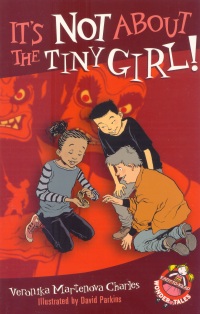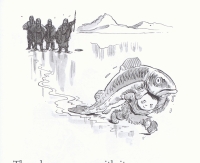| ________________
CM . . .
. Volume XIX Number 29. . . .March 29, 2013
excerpt:
In this book based on the story of Thumbelina, Charles again sets up her stories as told by three children, Lily, Ben and Jake. Lily’s bringing a walnut shell with a tiny doll for Show and Tell starts the children thinking about stories with a small person as the main character. The first story, which is told by Jake, is not about a tiny girl, but a boy, and it is based on a story from Chile. It is called “Peanut Boy”. A woman takes in a traveler to give him a meal. She has told him that she and her husband are lonely without children, and the traveler gives her a peanut which he tells her to plant and she will get her wish. When it grows, a tiny boy is inside. They worry because he doesn’t grow. One day, they go out and leave him at home. He is hiding behind a twig and is taken away by an eagle. Through an act of kindness, he grows to normal size and returns to his parents. Ben is reminded of a story in which a tiny boy fights ogres. This story, “Little Inch”, comes from Japan. A tiny boy is born the size of a fingertip. When he is older, he decides that he wants to go and see the world. He takes a sewing needle for protection and a rice bowl for a boat. He gets a job as a playmate for a master’s young daughter. One day, they are out for a walk and are attacked by ogres. The young boy’s quick thinking and his fighting off the ogres provide him with the power to become normal size. He becomes a samurai and returns to take care of his parents. The final story is told by Lily, and it comes from Native America. “Baby-Man” is the story of a young boy who lives with his sister. He doesn’t grow, but he is very strong and very fast. One day, he chases a ball onto the ice and encounters four men ice fishing. They tease the boy and throw his ball down one of the holes cut in the ice. The boy steals one of their fish, and they threaten to follow his tracks the next day and then kill him. The boy tells his sister what has happened, and when the men came to their cabin the next day, he pushes a huge rock and they run away. The boy and his sister have enough food from the fish for all of the spring. The division of the book is well done as three friends provide a framework for the telling of the stories with the initial item for the Show and Tell. There is a reason to think about the stories they remember. The children are realistic, and the language is age appropriate. This book is a good selection for children beginning to read chapter books. It would also be a good choice for a comparison of the Thumbelina theme. It is excellent that the stories are about male characters and Thumbelina is a girl. It’s Not About the Tiny Girl! would appeal to a wide range of readers. I would recommend this selection for public and school libraries for it is age appropriate and combines the telling of stories with fables from other countries. Highly Recommended. Deborah Mervold, an educator and teacher-librarian from Shellbrook, SK, is presently employed by the Saskatchewan Institute of Applied Science and Technology (SIAST) where she works in the areas of faculty training and program development. Kira Gerein is a Grade 5 student in Saskatoon, SK.
To comment
on this title or this review, send mail to cm@umanitoba.ca.
Copyright © the Manitoba Library Association. Reproduction for personal
use is permitted only if this copyright notice is maintained. Any
other reproduction is prohibited without permission.
NEXT REVIEW |
TABLE OF CONTENTS FOR THIS ISSUE
- March 29, 2013.
AUTHORS |
TITLES |
MEDIA REVIEWS |
PROFILES |
BACK ISSUES |
SEARCH |
CMARCHIVE |
HOME |

